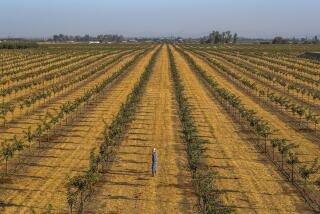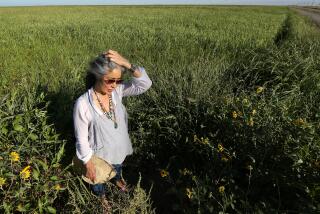Garlic Farmers Feel the Press From Abroad
- Share via
Don Christopher’s garlic fields have survived droughts and El Nino, gophers and beetles, white mold and roundworms.
But the founder of Christopher Ranch, the nation’s largest garlic producer, says low-priced imports from China could doom U.S. commercial production of the pungent bulb -- unless U.S. farmers adopt dramatic, if seemingly unpatriotic, measures.
After more than a decade of lobbying politicians for tariffs and trade regulations to ward off Chinese imports, Christopher Ranch began importing garlic from China in mid-July. Christopher’s largest competitor, Bakersfield-based Garlic Co., has said it would do the same. Smaller farms are expected to join them.
Christopher, whose Gilroy, Calif.-based company spent $400,000 last year on attorneys and lobbyists to fight Chinese imports, said he considered the move “unthinkable” six months ago. But the dramatic rise in imports from China in recent months has driven wholesale prices so low that customers, including restaurants and grocery chains, demanded bulbs for less than they cost to produce.
“We’ve held off the Chinese for 12 years, but now it’s time to give up,” Christopher said last month, as he surveyed a dusty garlic plot in nearly 100-degree heat. “We know there’s a market for California-grown garlic. But if you look at history, people always go for the least expensive price. There are no secrets to the garlic business -- it’s all about price.”
Gilroy, about 30 miles south of San Jose, has been losing garlic market share for five years. The city still crowns an annual Garlic Queen, sends young pickers to college on garlic scholarships, and hosts 100,000 visitors to the annual Gilroy Garlic Festival, which was held July 25-27.
But it’s unclear how long the city can hold on to its self-proclaimed status as “Garlic Capital of the World.” China produces 66% of the world’s supply of garlic, according to the U.S. Department of Agriculture, while the United States produces 3%. Nearly 70% of garlic sold in the United States during the off-peak winter and spring comes from overseas, according to the U.S. Census Bureau.
“Things evolve,” said Gilroy Mayor Thomas W. Springer, an IBM software engineer who is trying to reposition Gilroy from an agricultural backwater to a Silicon Valley biomedical hub with affordable land for technology labs and research parks. “We’ll keep celebrating garlic, even if it’s our heritage, and even if China is the world’s biggest garlic region.”
Garlic was ripe for Chinese domination because the 5,000-year-old plant, classified as both an herb and a vegetable, has a shelf life of as long as nine months. It can easily be stored and shipped around the world.
Chinese and American garlic taste similar. Chinese cloves are the same size and firmness as the California White that dominates U.S. store shelves, but Chinese garlic often has a tough, inedible stem in the center.
American garlic sells wholesale for 60 cents to 80 cents a pound, compared with 40 cents to 50 cents a pound for Chinese imports.
The average Chinese laborer gets about $1 a day, compared with about $8.50 an hour in California. China’s low wages have hampered imports from Mexico, where workers average about $5 a day.
The decline in U.S. commercial garlic production has been swift.
The average American consumed 3.1 pounds of garlic in 1999, nearly three times consumption in 1989.
But domestic farmers began struggling shortly after the first Chinese bulbs came to the United States in 1993, when they underpriced American garlic despite tariffs of 376%.
Growers say the bullish free trade policies of the Bush administration, and loopholes that eliminate tariffs, could speed their demise.
Christopher Ranch, which produces nearly one in three bulbs sold nationwide, will produce 70 million pounds of garlic this year, down 30% from the 100 million pounds it produced five years ago. The company plans to produce 55 million pounds in 2004.
Christopher, 68, a third-generation garlic farmer, said the withering of his industry makes it easier to turn the business over to his son, Bill. The company will focus on mechanical processing -- pressing garlic into oil or other products -- and peeled and organic cloves, for which consumers are willing to pay more.
“I’m a realist,” Bill Christopher said. “When we have our customers telling us, ‘We want to buy Chinese garlic,’ it doesn’t give us a choice.”
More to Read
Eat your way across L.A.
Get our weekly Tasting Notes newsletter for reviews, news and more.
You may occasionally receive promotional content from the Los Angeles Times.










